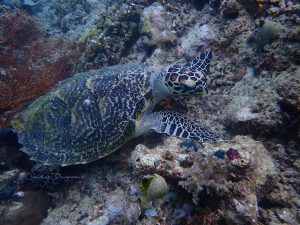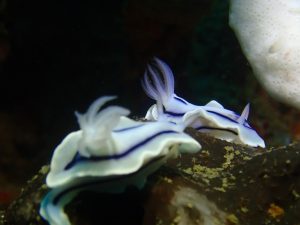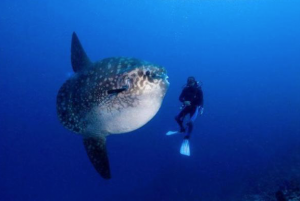Have you heard of the African BIG 5? When you go Scuba diving in Bali you’ll find that we also have our own Big 5 – Big 5 marine species that is! Our Big 5 list is made up of marine creatures which are very special to the dive sites around Bali and they are highlights of any Indonesia diving trip.
Read on to find out which epic species have made our list….

Oceanic manta – Manta Alley – Komodo National Park
Photo credit : Thomas Demesmaeker
Manta Rays (Manta Alfredi)
Join us on a trip to Nusa Penida just off Bali’s east coast and experience diving with the majestic manta rays. Manta rays are the largest species of sting ray on the planet, but unlike other members of the sting ray family, they do not have a stinging spine. These graceful giants are completely harmless and feed only on plankton and very small fish which they ingest through their huge, cavernous mouths.
Diving with manta rays is an experience of a life time as the swoop effortlessly overhead. Along the south coast of Nusa Penida there are two manta rays dive sites, one where we commonly see smaller individuhttps://abyssoceanworld.com/wp-admin/media-upload.php?post_id=9857&type=image&TB_iframe=1als feeding and one where we see the adults swarming around a “cleaning station”. Manta ray cleaning stations are large boulders or coral formations which attract hoards of small reef fish. The manta rays hover over the cleaning station and attract the small fish who then clean them of parasites.
Join us on our Bali Nomadic Safari and you’ll not only dive Nusa Penida, on this Bali Liveaboard style safari you’ll dive all of Bali’s top dive sites which gives you a greater chance of seeing all of Bali’s BIG 5!

Hawksbill Turtle captured at Menjangan Island by Claudine Daigneault
Hawksbill Turtle – (Eretmochelys Imbricata)
The hawksbill turtle is actually listed by the (IUCN) as critically endangered so we are extremely lucky to have such a thriving population visiting Bali. It’s possible to see these beautiful turtles at any Bali dive site and they are always a pleasure to watch as they swim by. It’s sharp and curved ‘beak’ makes it easily identifiable from other species at a glance but there are other distinguishing features to the Hawksbill; it has a flattened body shape and flipper like ‘arms’ which it uses for swimming and its shell is often covered in algae.
Hawksbills are one of the smaller turtle species measuring up to around 90cm in length but they can weigh up to 70kg. They are highly migratory and spend time in both the open ocean and in lagoons and on shallow reefs where they are often seen resting in caves or on ledges. When you are scuba diving in Bali, Padang Bai, Pemuteran, Tulamben, Menjangan Island and Nusa Penida all offer possible hawksbill encounters.
Hawksbills are omnivores with sea sponges making up a high percentage of their diet but they are also known to regularly feed on jellyfish and algae. They live up to 30 to 50 years and females nest only every two years when they return to the beach where they were born. Following mating the females come ashore to lay their eggs and bury them in sand – clutches can be up to 140 eggs but unhatched eggs are hunted and eaten by numerous land-dwelling species and newly hatched hawksbills fall victim to several sea predators – however, once a hawksbill reaches maturity it has few predators due to its size and hard shell. We are extremely lucky to see so many of these beautiful turtles when diving Bali. Take one of our Bali safari’s to see numerous turtles in one phenomenal trip!

White tip Shark captured by Gerald Lachance in Pemuteran
White Tip Reef Shark (Triaenodon obesus)
Here in Bali we are lucky enough to spot white tip reef sharks at many of our dives sites and we even have a few places where they seem to have made a part of the reef their permanent home.
The white tip reef shark is species of requiem shark which has a grey to brown colouration on the top of its body, a white underbelly and distinctive white tips to the anal and caudal fins (where the name “white tip” comes from). It is a small member of the shark family and grows from just 52 cm as a new born pup up to around only 1.6 meters when fully matured.
White tips are nocturnal hunters – sleeping fish inside corals are easy targets (!), by day they spend most of their time resting underneath ledges or on sandy bottoms and they are commonly found in caves such as those at Gili Tepekong and Mimpang on the east coast of Bali.
White tip reef sharks are not aggressive and we see them both individually and in pairs or even small groups. White tips are non-migratory and individuals stay in the same area for long periods – while they may move from place to place the distances they travel are small. This also means our Abyss Ocean World guides know the best places to see them when you are diving in Bali.

Willan’s Chromodoris captured in Lembeh by Claudine Daigneault
Nudibranch (Sp.)
Known as the “Jewels of the Sea”, nudibranch are a family of brightly coloured sea slugs. These tiny creatures pack some of the most distinctive colours and unique patterns in the ocean. When you are diving in Bali you can expect to see a plethora of different species which range in size, colour, shape and behavior.
If you are hoping to work on your underwater photography skills in Bali, nudibranch make excellent subject matters when shooting macro – and as they are slow movers you have plenty of time to line up the prefect shot.
We find nudibranch at all dive sites around Bali – from walls, reefs, wrecks and even on sandy bottoms – you wouldn’t be in Bali if you didn’t spot numerous individuals on a single dive.
The US Liberty in Tulamben is one Bali dive site which attracts some of the rarest species on the planet – and some of the most elegant. Let your Abyss Dive Guides know that you are interested in nudibranch and they’ll delight in finding you some of the most unique species.

Mola – Mola
Photo credit : Kevin Deacon
Mola (Mola Ramsayi)
The sunfish is one of the strangest looking fish in the ocean and yet one that divers often place highly on their lists of ‘things to see’. As the heaviest known bony fish in the world and weighing in at over 2,200lbs the mola has two dorsal fins making it as tall as it is long. The most distinguishing feature of the mola is its main body area – of which there is very little – and which is flattened laterally.
Mola live on a diet of nutritionally poor jelly fish and to maintain their body weight they consume huge quantities. Ordinarily they are deep water fish but they are seen around Nusa Penida from July to October as they drift up the reefs on the cold thermoclines making their way into the shallower waters. Year round mola carry an incredibly heavy parasitic load and these giant fish rely on some of the reefs smallest inhabitants to unburden them through cleaning.
They are a truly Jurassic looking fish which, as a member of the order Tetraodontiformes, are closely related to pufferfish, porcupine fish and triggerfish. The mola is also referred to as the Balinese Sunfish (or Moonfish to the French – Poisson Lune). The name sunfish is thought to come from its habit of ‘sunbathing’ on the surface of the water.
Join us for our Bali Nomadic Safari between July and October for your best chances of a mola encounter while scuba diving Bali.
Have you seen any of these marine creatures already? Join us in Bali and you won’t be disappointed – we have regular sightings so many divers are even lucky enough to see all 5 in one trip!
Check Out Our Recent Guest Comment:
BEST DIVING EXPERIENCE I HAD IN BALI!
If you are planning to dive in Bali this is the company to go with no matter your skill level. I spent two months in Bali diving and Abyss is the best! … The entire crew is outstanding and attentive….
I would recommend this company to anyone planning to dive in Bali. Additionally, check out their “dive safari’s” I learned about them after I was already in Bali so I missed out. I am already planning my next trip so I don’t miss out again! Keri S, March 17th 2018
So what are you waiting for? Dive into action and book your next scuba diving in Bali adventure and join us in Bali: info@abyssoceanworld.com
We look forward to diving with you in Bali soon!






